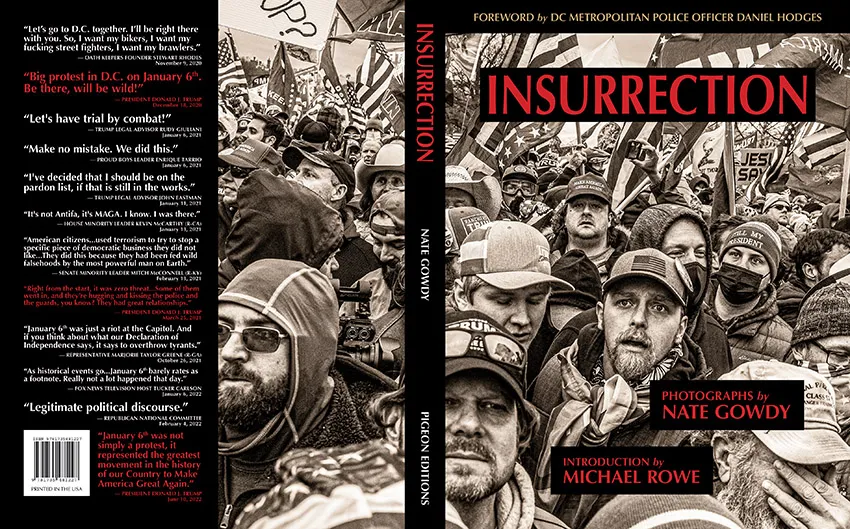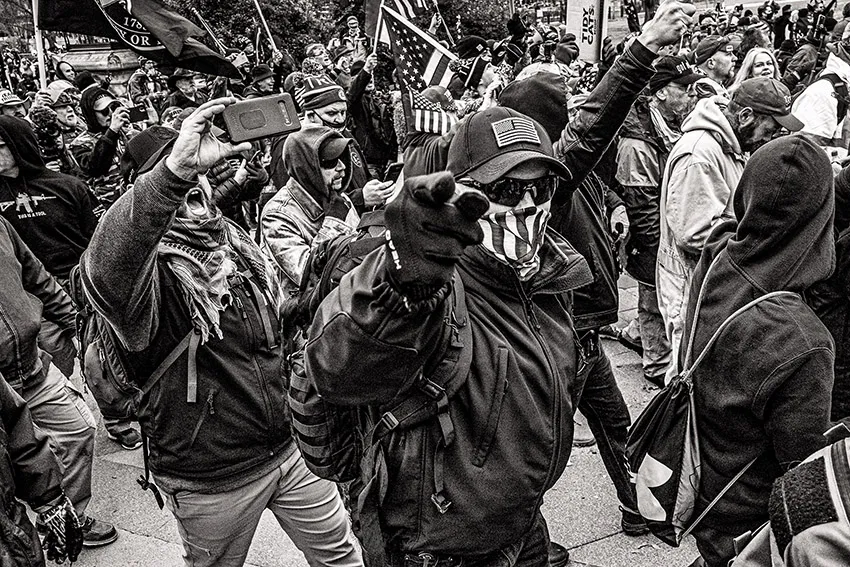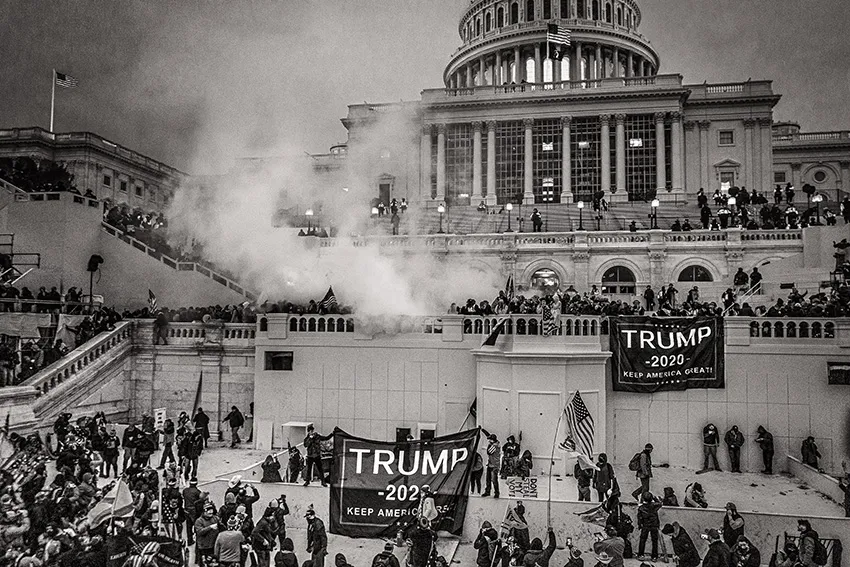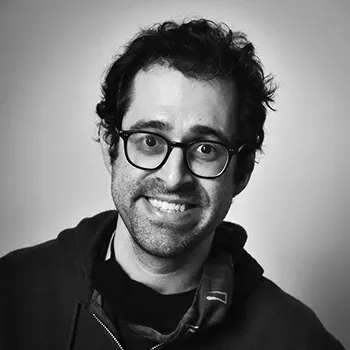In the two years since the insurrection of January 6, 2021, 978 people have been charged, 335 have been sentenced, and former president Donald Trump has been referred to the Department of Justice on four charges. Despite a myriad of documentaries, numerous special investigations, and a mountain of news reporting, many Americans remain divided over what happened in Washington, DC, that day.
Now, one eyewitness is ready to share his firsthand account. Photographer Nate Gowdy was there for Rolling Stone. He had been following the rise of right-wing extremism as a photojournalist since 2015. For six years, Gowdy had documented Trump rallies, events, and protests. While he had surely seen his fair share of madness, nothing could have prepared him for what he was about to encounter.
Trump's last stand?
"I was thinking this would be my grand finale of the coverage of Trump," said Gowdy, who had been planning to turn his coverage into a book. "I saw it as his last stand. It was going to be the end of that book – and maybe, hopefully, someday, I will get to that book."
Within just 12 hours, however, his conception changed entirely. "I thought it was the end of something, but it turned out that it was rather the start of something."
Gowdy's coverage of the historic events of January 6 happened nearly by chance. The Seattle-based photographer had not intended to travel across the country for what people at the time were assuming would be just another Trump rally.
"I was already out east. I was visiting family in Indiana," he explained. The pandemic was still raging. "It was important for me to be with my immediate family, because it was our first holiday after losing my mom, likely to COVID, nearly a year before."
Gowdy hadn't intended to cover any news while he was traveling. He didn't even bring all his camera gear. However, he decided to take a chance and photograph Donald Trump one last time.
"I went to Atlanta first, because it was the runoff election [for the Senate], which was on the fence. So, I was there leading up to it, and there was a Trump rally on the 4th [of January], in rural Georgia. I figured, again, [this was] the last chance to photograph this kind of thing and document this moment that we originally thought was a blip in 2016.
"I knew things were going to be going on, because I had been following the news. There was a big 'Save America' rally; other people were calling it the 'Stop the Steal' rally, and I think that name for it was more prelevant."
A polarizing flight
From the moment Gowdy stepped foot on the plane to the nation's capital, he realized he was taking part in something bigger than the other events he had documented.
"Half the people on that plane were white and wearing MAGA paraphernalia, red hats and all, and the other half were predominantly of color, just trying to travel from one place to another in peace. The dichotomy of people's views had never been so in my face."
The energy, rage, and nationalism the soon-to-be rioters displayed fed right into what much of the public has come to associate with white supremacy. "The Trump crowd kept trying to start chants of 'Four more years' and 'USA, USA' and 'Donald Trump,' and it was just obnoxious," Gowdy recalled. "Finally, someone booed, and then a Trumper yelled, 'Go back to Venezuela!'
"I knew it would be weird. That's why I went. [But] I had no idea the Capitol would be attacked the way it was and that day would become deadly."
Optics
The inability of police to fend off the crowds did lead to deadly altercations. Since January 6, 2021, many Americans have critiqued the Capitol Police for how they handled the situation and speculated that they knew more about it than they let on. Gowdy has his speculations as to the reasons for the lack of riot control on that day.
"I think they did know, but I also think they were very fearful of the optics, and they said as much if you research it: they were afraid of the optics of sending the National Guard and fortifying the Capitol building," he said.
Gowdy is familiar with photographing protests, and he believes that the lack of police protections may have been a result of anti-police brutality protests from earlier in the year.
"That was a consequence of DC being fortified [with] over 5,000 troops at the height of the George Floyd protest. That got a lot of criticism. They didn't want a repeat of that, but of course, there was a difference. They militarized the city when there were racial justice and anti-police brutality protests, but now that these white people [were] demonstrating over a fake stolen election or whatever you call it, it's just the opposite."

"Photos don't lie"
Gowdy's observations of the day, reflections after the event, and historical context provide framing for the stunning images in his newly released book, Insurrection, which provides a visual play-by-play of what he saw and experienced that day, unlike other firsthand accounts and stories told by people from both sides.
"Photos don't lie. It's easy to take bad photos of anybody. These aren't bad photos," he said. "Sure, my words and opinions are in the book, but the photos can, and do, speak for themselves. I'm just adding a little context from my perspective."
When he was documenting the events of January 6, Gowdy wasn't trying to push any ideology. "My job as a photographer is basically to make people look good, and I'm very good at that, and I enjoy doing that, but the bottom line is always making my clients look good. There's a lot of freedom in just being able to see what I see and not having to make flattering pictures of these people. Not that I'm out to make them look bad: that's just how they look. And I photograph the left, which is where I stand, the same way. I don't change the way I make pictures or the way I see."
While hundreds of thousands of pictures have come out of that day, something sets Gowdy's apart from the rest.
"If you put a bunch of images from that day on a wall, from different photographers, you would likely see a lot of color images," he explained. "You'd likely see a lot of subtly toned color images, and then you'd see mine, and you'd know it was mine, because the processing is more aggressive. I think I like black-and-white because the frames feel finished to me. I'm always tweaking the color with my editing – I'm never as sure about it, it's not as final to me. When you take that away, it's another way of seeing it."
Another reason Gowdy's images are always black-and-white is that it evokes historical significance. "It almost puts it in perspective as a historical event. Black-and-white [is] timeless," he said. "I am constantly inspired by the [black-and-white] news imagery from the '60s and '70s, which were very turbulent times in this country."
Gowdy is also inspired by photographers like Diane Arbus and Robert Frank, who were known for documenting people and events far removed from their own experiences. "I like to think I've fallen into my style, but before I was even a photographer I was drawn to the work of Diane Arbus. You see, she photographed ...intimate photographs of outsiders, and who they called at the time 'freaks' and such.
"Well, look at me. I started my career photographing drag queens. Look at the parallels. I got into Arbus' stuff in the mid-2000s and then years later found myself photographing a similar audience, people on the fringes. So she's a huge inspiration."
Gowdy was also inspired by Robert Frank, who published The Americans. "He's an immigrant and he photographed America as an outsider, as a new resident of this country," Gowdy explained. "I am not an American outsider, but I am an outsider to MAGA, you know, the whole... whatever's going on in there. I enjoy photographing that crowd because it's freeing. It's liberating."

Across enemy lines
Through his photography, Gowdy was able to do something liberals are often accused of avoiding: listening to the other side. Now, he's sharing what he's seen with readers who might not be able to blend in as he did.
"It's a way of seeing what it looked like from the insurrectionists' viewpoints, because I was ...crushed between them. ...It's something people can learn from and kind of start to grasp what went down that day."
While the photographs, the editing, and nearly all the text in the book are from Gowdy's account and research, Insurrection could not have been complete without the generous contributions and support of some of his friends.
"I don't consider this book complete without the words of my introduction writer, Michael Rowe, who is a Canadian horror novelist, an experienced journalist, and a fantastic writer, and he has a great way with words. Also the work of my foreword writer, DC Metropolitan Police officer Daniel Hodges."
Photos helped lead to convictions
Gowdy's work not only was significant as historical documentation of the day but has also aided federal investigations and led to the arrests and convictions of many rioters.
"I'm proud of the fact that these photos have been used to hold insurrectionists accountable," he said. "Many of my images, the raw photos, the unprocessed color image files, have been used as the images on the FBI's Most Wanted List for that day."
One image that made it into the book was of AP photojournalist John Manchillo shortly before four rioters shoved him off a five-foot tall retaining wall. "I was almost an eyewitness in a federal trial against [the] four assailants," Gowdy said. "One photo of him being escorted away is in the book. Not the best photo, but a powerful one. Just what was happening to journalists."
The trial involving Manchillo ended in a plea deal, but it wasn't the last time Gowdy was contacted to help bring rioters to justice.
"In July, CREW found me," he said. "They're Citizens for Responsibility and Ethics in Washington. They are a force for good. A lot of activist lawyers and a lot of the news and lawsuits you see [regarding] government accountability, they're the ones instigating those. They found me, and it turned out that I could help them."
CREW had been searching for a nonhostile witness to help put away a key figure from the insurrection. "Not only did I have eyes on the defendant in the case, but he was in 5% of my images from that day," Gowdy said. "I wasn't focused on him necessarily; he was just in the middle of the scene, trying to insert himself in a leadership role.
"His name is Couy Griffin. He [was] an Otero County commissioner in New Mexico, and he is also the founder of Cowboys for Trump. It was hard to miss him – there weren't a lot of cowboy hats that day."
Thanks in part to Gowdy's images, Griffin was convicted of trespassing and then became the first person removed from office for insurrection since 1869. "I was one of four witnesses," Gowdy said. "Two were expert witnesses, one on insurrection, another...on right-wing violence across the world. I was the eyewitness who photographed him, and they used my images as evidence."
The trial for Griffin was also the first time Gowdy met Officer Hodges, who wrote the foreword to the book. "Hodges was a witness [who drove] home that it was a violent day. He experienced the worst of it. He says it in his foreword.
"I'm just so impressed by him. I've had a lot of gnarly experiences with police officers, especially here in Seattle with the SPD and [in] Portland. A lot of contentious interactions and a lot of examples of my colleagues being attacked and injured by them, so I'm not a huge fan of police in general. But Daniel Hodges, I couldn't have more respect for anyone. He is still working the night shift on the force in DC, and in his free time he's been trying to expose these people and all the disinformation and lies [put forth] by the right-wing echo chamber."

"I should have been a lot more afraid"
As more time passes since the horrific events of January 6, 2021, Gowdy has gained more wisdom in hindsight. While he may not have understood the scope of what was going on at the time, he was very much in danger during the protests.
"I was attacked twice," Gowdy recalled. "One was ten minutes into it, [when I crossed] paths with a gang of militiamen who turned out to be the Proud Boys ...ditching Trump's rally before it even began and marching towards the Capitol, chanting 'Fuck antifa!' I got lunged at, but he didn't touch me.
"I learned that if [I] respect their space and have a camera, they're typically unlikely to attack me, because they're aware of optics, too, and public perception. My camera is my weapon. I have some power. It surprised me when they attacked me so blatantly and unprovoked, seemingly. So I just kept my distance until some other photojournalists caught up to us. I was the first nonembedded photojournalist walking with them that morning."
Being one of the first photojournalists in the crowd provided Gowdy with the opportunity to see parts of the insurrection that were less documented, some of which sent a chill down his spine.
"They did a prewar prayer, which was very scary. Throughout mankind's history, we've done some terrible things in the names of our gods, so that made me afraid that they were praying about what they planned to do."
The energy picked up after noon, and Gowdy soon realized what the prayers were all about.
"Five police patrols were swiftly overpowered. One woman officer was knocked out, and I was attacked again. ...He pointed at me, yelled 'Fuck you!' and shoved me for merely having a camera. I was called 'fake news' throughout the morning, and antifa, which is a right-wing bogeyman."
Despite everything, Gowdy doesn't recall feeling much fear.
"I don't remember feeling that afraid, but I remember being on my toes throughout the day, because I was being monitored. I had been attacked twice, and I had to be very discreet about taking all my images – very very discreet. Now when I watch the footage, I feel like I should have been much more fearful than I was in the moment."
With the trials continuing, the DOJ investigating the former president, and eyewitness stories like Gowdy's being released to the public (not to mention the televised House January 6 Committee hearings), Americans are learning more about the truth behind what happened on January 6. Nate Gowdy's Insurrection is a harrowing contribution to that, an account of the day's events from the perspective of those leading the charge.


